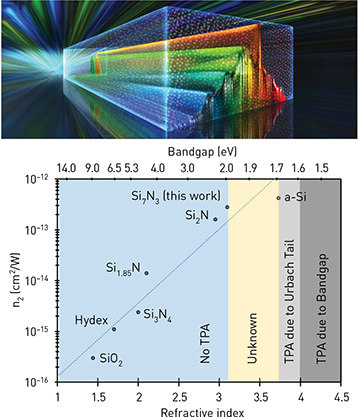 Top: Optical signals propagating through the USRN amplifier experience 42.5 dB gain. Bottom: CMOS amorphous solids on a refractive-index and band gap scale.
Top: Optical signals propagating through the USRN amplifier experience 42.5 dB gain. Bottom: CMOS amorphous solids on a refractive-index and band gap scale.
The optical parametric amplifier (OPA) is a critical component in CMOS photonic systems, as it replenishes the optical signal’s intensity after depletion due to optical losses, and thereby safeguards the signal’s integrity. An OPA’s efficiency relies on the Kerr nonlinearity of its material as well as on the absence of losses from nonlinear two-photon absorption (TPA).
Miller’s rule and the Kramers–Kronig relations, considered in tandem, imply that the optical nonlinearity increases with decreasing band gap1; however, a small band gap turns on the TPA process that degrades the OPA’s efficiency. High-band-gap materials, such as stoichiometric silicon nitride, have no TPA but also have very low nonlinear coefficients. At the other extreme, low-band-gap materials, such as amorphous silicon, have very high optical nonlinearity, but with the presence of TPA.
In recent years, we have established that the band gap of CMOS materials can be engineered by adjusting the compound’s stoichiometry.2,3 Between amorphous silicon (a-Si) and stoichiometric silicon nitride (Si3N4), there exists an array of permutations in the ratio of silicon and nitrogen atoms: the higher amount of silicon, the lower the band gap. As such, a “sweet spot” should exist among these permutations that sits at the cliff of high nonlinearity and the edge of the TPA phenomenon.
With recent advancements in fabrication technology, it has become possible to consistently and homogeneously grow high-quality nitride films with ultra-silicon-rich content.3 Our exploration of these band-gap-engineered silicon nitride films has led us to Si7N3, an alloy that we have christened as ultra-silicon-rich nitride (USRN),4 with a band gap of 2.1 eV. This is by far the highest silicon-to-nitride ratio, with our closest contender being Si2N.5 The OPA we built using USRN performed exceptionally well, with a 42.5 dB gain and no TPA losses.
Notwithstanding the success of our USRN films, there is still room for improvement in the band-gap region between 1.7 and 2.1 eV where the TPA process may still be suppressed. As fabrication technologies continue to improve, it’s possible that new limits for CMOS optical nonlinearities will be broken and even higher OPA gains achieved.
Researchers
K.J.A. Ooi and D.T.H. Tan, Singapore University of Technology and Design, Singapore
D.K.T. Ng, Agency for Science, Technology and Research (A*STAR), Singapore
L.C. Kimerling and A.M. Agarwal, Massachusetts Institute of Technology, Cambridge, Mass., USA
References
1. R.C. Miller. Appl. Phys. Lett. 5, 17 (1964).
2. T. Wang et al. Laser Photon. Rev. 9, 498 (2015).
3. D.K.T. Ng et al. ACS Appl. Mater. Interfaces 7, 21884 (2015).
4. K.J.A. Ooi et al. Nat. Commun. 8, 13878 (2017).
5. G.R. Lin et al. Sci. Rep. 5, 9611 (2015).
